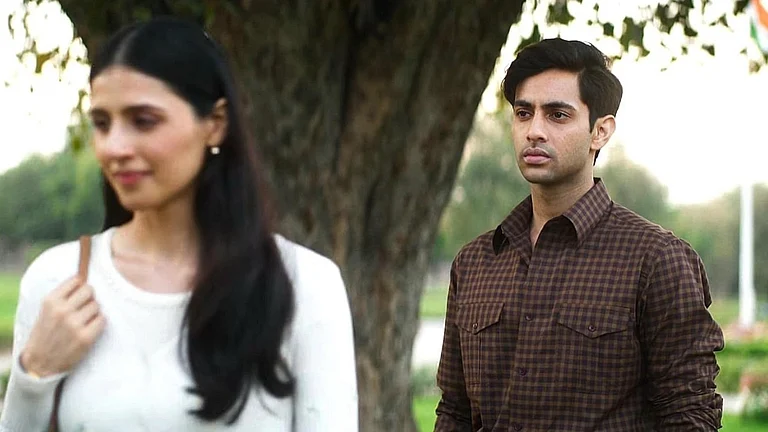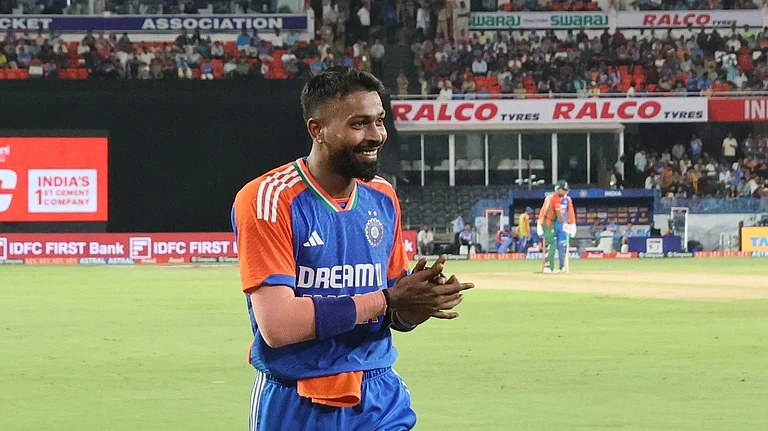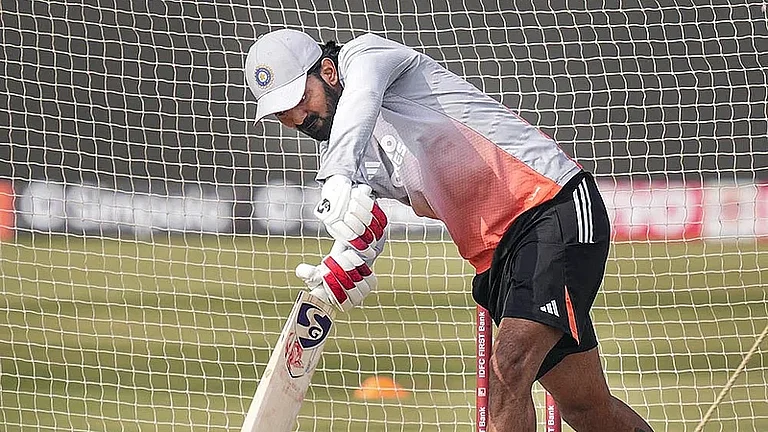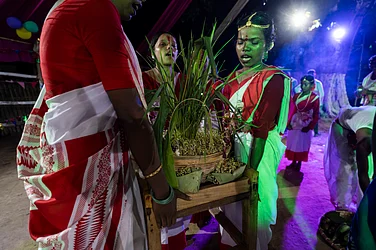After the cataclysm comes the desperate, collective hunt for catharsis. And since that will always prove elusive in a real, enduring sense, at least a modicum of sense-making. We’ve been witnessing a near-eruption of sex crimes in public—women being chased by droves of yahoos during New Year-eve revelries, recalling some primordial ‘war loot’ scene, turning Bangalore’s strobe-lit Brigade Road into its own photographic negative; a young woman accosted on a dark bylane by two scooter-borne men, and left reeling afterward like a used plastic bottle; another woman mobbed by ‘students’ on a busy Delhi street…. And we can only guess at the countless many that went unrecorded (and thus escaped being circulated and consumed voyeuristically in video form).
Yes, these are all ‘lesser’ crimes perhaps in the IPC hierarchy, but no less pathological for that. There are common threads. One is a statement of an implied power code, a de facto law of the land: a woman in a public space seems to perforce forfeit her rights to be a human being, or keep them in suspension. As if to say, if you transgress your limits, all bets are off. As if they have to be shamed, reduced to prey. The other is the utter unfeelingness of the male protagonist, almost become an automaton, or a Pavlov’s dog.

People protest against the 2017-eve molestation in Bangalore
Both phenomena go together, and the answers may well be conjoined, like strands in a DNA. For now, there are only questions, for ordinary citizen and analyst alike. Why are women being molested, raped, groped, shoved around…almost as a routine fact of life, like trains running late or the temperatures dipping in winter? Just what is going on with the Indian male? Are we staring at a perverse form of the old nature-versus-nurture debate? As in, are they born like that or is it the upbringing, the social conditioning that has turned them into sexual predators? Why does psychopathic profiling seem best suited to explain their behaviour? And why does it look as if this goes beyond the basic premise of criminology—that of the ‘sick, deviant mind’ set against normal citizenry—almost as if the sickness has been universalised? They say everyone in India actually has TB, it’s only the immunity that saves most. Likewise, is a sort of sexual vengefulness the ‘new normal’ across large swathes of Indian malehood?
“We’ve become desensitised to what others experience because of our actions,” says Dr Samir Parikh, psychiatrist and director, Fortis, in Gurgaon and Delhi. In ‘normal’ times, this happens during war, when empathy is systematically denied to the ‘enemy’, who’s somewhere outside. Turned inward, what does this imply: that everyone is an enemy? These are the classic marks of a psychopath’s mind: an extreme form of narcissism where everyone is a potential enemy, zero capacity for empathic emotion or sensitivity towards others, feeling responsible only towards your own needs, a tendency to violence, an utter lack of conscience or remorse. It’s only with a shudder that you tick off those boxes, as you realise how normal those traits are, barring the last. And at a time of intense stress, even that safety net may be lifting.
Look back to the Nirbhaya tragedy of 2012 and its convulsive aftermath, the mass outrage that led to laws more stringent than ever. Instead of conscientising society, it seemed to produce the opposite effect. In retrospect, was there a touch of sadistic prurience in how all the gory reportage was consumed? Almost amazingly, violent sexual crimes seemed to only grow from that point on. And this instinct to violence, as far as ordinary citizens can tell, has now taken an even more brazen turn, for in Bangalore it was public. Has a departure has been marked from the old clandestine, cloaked, harassment to something more calamitous? Has the Indian male gone feral collectively?
In all the analysis, that’s the one crucial element left out—the tormentor himself. Nobody knows what precisely ticks in his mind. He never steps out of the shadows. Not just from law, his mind is under a cloak even for family. Around ten psychiatrists, psychoanalysts, police officials and sociologists, asked whether such men are known to feel any remorse, cited this thick fog of secrecy. It’s one of the reasons why the family, confronted with his crime, leaps to his defence or alleges conspiracies against a doting son, brother or husband. After long years of being conditioned as a primus inter pares between siblings of the opposite sex, fed, cosseted and brought up as a rightful inheritor of property, is the Indian male unable to adjust to a new powerlessness in a changed world?
Or is there a larger, social failing? “What we are witnessing is a decay in attitudes towards gender at a collective level,” says Dr Parikh. And as “silent bystanders to crime,” we’re becoming inured—and worse, complicit. All the transgressions we witness daily, the individual ‘incidents’, the everyday brutalities of talk shows, reality TV and gender-targeted online trolling, the mindless, sexist chatter of people in power, the throwaway obiter dicta of judges—all this ultimately “disinhibits” the potential rapist/molester. “Then, one day we find what was happening at an individual level in buses, mohallas, metros and housing societies has got collectivised.”
It was on Brigade Road that the crime graph, rising anecdotally till now, touched a different kind of crest. In the mass-desensitised environment, the crowd became a frightening thing: both a refuge and a living beast in itself. It allowed both public anonymity, and a herd instinct. The nameless, faceless man who individually, furtively, groped a girl on the bus had become part of a faceless army, what psychiatrists call “deindividuation”—loss of individual identity. What brings about a Brigade Road moment? Dr Alok Sarin, psychiatrist at the Sitaram Bharatiya Institute of Science and Research, says what sets apart group crimes is that they tend to occur more frequently in societies in transition.
Crimes against women in a riot or riot-like situation—which imitate conditions of war—are not rare. So are we headed for a permanent state of war? “There aren’t simple answers but we know that large-scale problematic behaviour tends to occur in societies in flux, due to a mix of anthropological, social and psychological factors,” says Dr Sarin. “However, after communal riots such as in 1984 or the Partition, we know people do feel guilt, later. But they do not have a language to express that guilt in. They find it difficult to articulate remorse. So, if there’s a larger social discourse, that expression becomes easier.”
But before we look for curative measures, we must get closer to a diagnosis. Our societies were anyway built on individualism, with the old certitudes of community cast behind. Has the flux of the post-reforms era destabilised even the settled urban behaviour of old? Cities like Calcutta and Bangalore, once placid zones, have been increasingly reporting violent sex crimes. Our cities are in a phase of violent growth, with huge demographic changes. Our politics is degraded. On gender, even the law often functions as a bulwark of patriarchy rather than as a reformist advance guard (the rape of a “virgin” is often seen as a higher crime by judges). The subaltern always felt a sense of powerlessness; now even the middle class imitates that.
Into this embattled public zone comes the woman, claiming equal space. And the male is reacting with vengeful violence. It’s almost like xenophopic rage against immigrants, or the class hatred of the old elite against ‘backwards’. Almost as if the woman is an ethnic foreigner in the public space. Or a ‘gender dalit’, seeking parity.
Villages are no less in flux. Caste panchayats routinely order rape as retribution in a time of gender, caste and subaltern assertion. A caste panchayat in Maharashtra recently let a man abandon his wife for failing a virginity test. A khap in Uttarakhand ordered the rape of two sisters as revenge for their brother’s elopement. Retributive justice or strict law-and-order won’t suffice here. We need conversations about sexuality, rights and masculinity, says Dr Sarin, adding that a society in the throes of transition has to manage desire and desirability. “Yes, a very big task but civilisation itself is a big task.”
At the micro level, the ‘criminal’ mind has been mapped to a large extent. He is a person for whom the “self” matters, not the consequences of his actions on others. He gets a “kick” out of harassing women. “He starts with smaller transgressions, staring, pinching girls surreptitiously, then builds up to get a greater kick from ever-worsening crimes,” says Dr Parikh. “Remorse...I don’t think there’s any.” Alarmingly, none of this need be accompanied by actual psychological impairment. “I also warn against believing sexual crimes are more common in certain social groups or locations. Men from upper echelons are not touched by police, simple as that,” says Dr Rajat Mitra, a psychologist who has worked with victims and perpetrators of crime.
Mitra used to find crimes of a sexual nature to be “a totally private hobby”—the exception is the peer group, with whom the man shares his habit, getting encouragement in return. “A young man told me once he would tell his friends, ‘chal, ladki chhed ke aatey hain’—come, let’s go harass girls. That is how banal it is. This is the only way they get a high. Hence, you won’t find them remorseful,” he says. To their mind, the dreadful moment when they are caught shatters their fun—“fun”, they often believe, the victim shared too. They are furtive: harassing women openly would expose them as terrible sons, brothers, husbands or fathers—that’s why Mitra sees no correlation between a molester and his own relationships with a wife, sister or mother.
But the lone wolf is an old species. “Not anymore are crimes against women private or furtive—I would say the increasing cases of gangrapes point to this barrier falling rapidly,” says Bula Bhadra, sociology professor, University of Calcutta. She blames the abysmal standards of public discourse. “In India, politics makes people partners in crime,” she says. “Political parties’ followers are akin to disciples, the leaders like gurus whom nobody questions. An Abu Azmi’s remarks are an IPC offence. He ought to have been arrested—but no leader was ever arrested for commenting, after any reported rape, on the time of day a woman was outside or the length of her skirt.”
Last week, Abu Azmi, a Samajwadi Party leader, said it was a “skin show” at Brigade Road, and molestation was inevitable. His party boss Mulayam Singh Yadav, two years ago, had uttered the axiomatic “boys will be boys” line, calling rape a “mistake”. And khaps—essentially male peer groups—are both sanctioning and legitimising offences against women by diktat. All talk of women’s empowerment, technical advancements and other well-sounding concepts turn into “shibboleths”, says Bhadra, in the face of such normalisation of crime.
Amid all the rapid change in norms, definitions are blurred. The very act of wooing a woman can often be strikingly close in form to what are legally labelled as crimes of sexual harassment and stalking (as it has been in pulp cinema for decades). Hence the curious sight, more common in smaller cities, of boys and men collecting outside girls’ hostels, colleges and schools to openly stare at girls as they pour out. “Sometimes, even eye contact with a girl in such situations gives the impression to the male that he has forged some kind of connection,” says Dr Dilip K. Puri, a psychiatrist in Rohtak, Haryana. “In the periphery, away from metropolises, women are scarcer in public spaces. There are many rules here for boys to interact with girls. The genders are kept apart, isolated—if there was more mixing, maybe we wouldn’t see so much harassment,” Puri says. The old is transiting to the new but nobody knows what the norms are—hence, in Uttar Pradesh, MMS clips of supposedly actual rapes and gangrapes are being sold as pornography.
Puri also draws a distinction between those with actual psychological sexual disorders and others who routinely see women as items of consumption. “The people who do chhed-chhad—sexually harrass, molest and so on—are a hardcore type with anti-social traits, similar to psychopaths in my view. In my experience, they do not care if they are labelled badmash, nor does social isolation as a consequence of their behaviour worry them,” he says.
“Conversations about how boys should behave or talk are not taking place,” says Mumbai-based Harish Sadani, co-founder, Men Against Violence and Abuse. “To change the male mindset, one needs to deconstruct the existing one. Men are hypersexualised, bombarded with media images objectifying women, simmering without knowing how to express themselves. There is no space for their expression either.”
Sadani, like all other experts, feels it’s no coincidence the accused in the Nirbhaya and Shakti Mills cases watched pornography. “Porn signals to men, in a very powerful way, what a man is and what a woman is—stereotypes of subservience, man on top and so on are perpetuated. Those images linger on in the absence of a healthy dialogue on sexuality,” he says. But how does one start on that when big personages like K.P.S. Gill, R.K. Pachauri or Tarun Tejpal have been docked for sexual harassment or worse, and all the signalling comes from a Donald Trump, in whose person politics and pornography come together, belying notions that either is benign.
By Pragya Singh with inputs from Prachi Pinglay Plumber in Mumbai


























